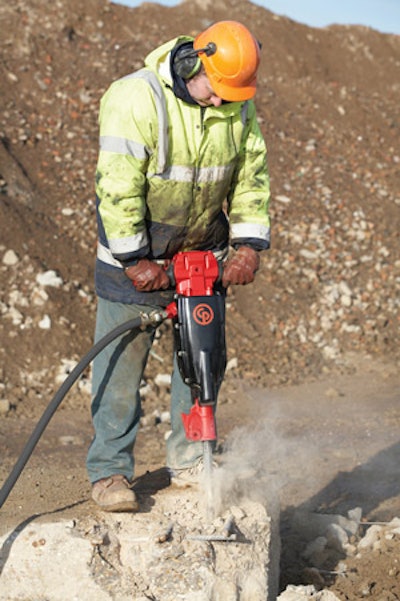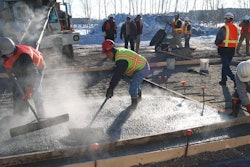
Concrete contractors often spend their workdays placing new concrete, but on occasion they're also called on to remove old concrete from a work site. The first step in the demolition process is finding a piece of breaking equipment that's easy to work with and efficient. This story is a breakdown of the concrete breaking equipment available on the market for light to mid-sized concrete demolition jobs. All these products can break concrete - you want to make sure that you choose a machine that will help you do a job in the quickest and most sensible way to save time and therefore money.
Hand-held breakers
Hand-held concrete breaking equipment is available in a range of sizes. The 60- and 90-lb. classes of hand-held breakers are popular among general contractors and are effective in breaking up sidewalks, curbs and city streets. They can also be used in situations where rig-mounted breakers couldn't maneuver or would be too big, like alleyways, bridge decks and tight spaces. Models in the 30-, 40-, and 50-lb. classes can be used on small commercial and residential applications with less stress on the operator.
Contractors can choose from pneumatic, two-cycle gas and hydraulic hand-held concrete breaking equipment. Pneumatic power systems are very popular in the industry, and convenient for many operators.
"The nice thing about air compressors is they are everywhere," says Jonathan Cook, key account manager with Chicago Pneumatic Construction Tools. "Some contractors might already own one, and if not, they can be found at every rental store."
Eudes Defoe, applications manager - handheld products with Atlas Copco Construction Tools, LLC, says he has seen a rise in the number of hydraulic breakers in the field. "The power-to-weight ratio of hydraulic breakers is usually about 30 percent greater than pneumatic machines in the same class," he says. "[A contractor] can use a 40-lb. hydraulic breaker that will deliver the same impact energy as a 60-lb. pneumatic breaker."
Defoe adds that hydraulic power packs generally weigh about 200 lbs., so can be easily transported. "Another advantage of a hydraulic breaker or tool for a contractor," he adds, "is that the breaker can be run using hydraulic flow from other carriers that are already on the jobsite."
Contractors using hand-held breaking equipment need to don the proper safety attire, including but not limited to, safety glasses, steel-toed boots, hard hats, earplugs and gloves. Manufacturers have done a lot to make this type of equipment more comfortable and safe to operate. "There have been a lot of ergonomic developments in hand-held breakers with noise dampening and spring-loaded handles that reduce the vibrations going from the tool to the operator," Cook says.
"With our hydraulic line, we're also able to offer a product that isn't as noisy," Defoe says. "And since everything is enclosed within the breaker, there's no need to worry about fumes or other emissions if you're breaking concrete in a confined area."
Rig-mounted breakers
Rig-mounted hydraulic breakers are available for units from remote control excavators and the smallest skid-steer loaders up to the biggest excavators. Generally speaking, you wouldn't have to choose between a rig-mounted breaker and a hand-held breaker - the ability to finish a project in a timely fashion and the power required for the breaking would have more to do with choosing one of these products over another.
Small and medium-sized rig-mounted breakers are easy to transport and are often purchased or rented by contractors who own compact equipment. They are commonly used for light demolition, breaking concrete foundations, landscaping and building renovation.
Rich Elliott, hydraulic applications manager with Atlas Copco Construction Tools, LLC, says hydraulic breaker power-to-weight ratios have improved in recent years, packing more punch into a smaller package. "In many cases, contractors are now able to use a lighter unit on a smaller carrier, and they still are able to get greater impact energy from the breaker," Elliott explains.
Recent advancements in breaker attachments technology also have made them easier to use and less stressful on the host machine. Atlas Copco offers AutoControl, which automatically adjusts the output energy of the breaker to match the requirements of the material being broken, and AutoStop, which will automatically stop the breaker operation before a damaging blank fire can occur. Manufacturers have also added vibration dampening and silencing systems to make rig-mounted breakers a little easier on the ears for the people working around them.
"Many people mistakenly judge a breaker by its sound and figure that it isn't doing its job unless it's making a ton of noise. In reality, it's likely that a noisy breaker isn't performing as well as a quieter one," Elliott says.
Drop hammer breakers
Concrete contractors looking to break up flat areas of concrete, such as driveways, sidewalks, patios and the like, might want to consider utilizing a drop hammer breaker attachment. Although limited to flat work, the drop hammer is a leading choice for such applications because of its speed, reduced vibration, ease of use and safety.
"The drop hammer produces less stress on the machine and operator than hydraulic breakers," says Justin Odegaard, Bobcat Co. attachment product representative. "This is accomplished because the ground absorbs the impact - rather than the machine and operator - thereby enabling the operator to work longer with less fatigue."
An additional benefit of the drop hammer breaker is that it leaves the surface of the jobsite relatively intact - there are no chunks of concrete or rebar jutting out of the pavement, which makes driving on the worksite easier and reduces tire wear. And contractors might find drop hammer attachments convenient in residential demolition applications or other situations where there are structures or objects in the area that need to be protected from flying concrete pieces.
"From a safety standpoint, one really nice thing about drop hammers is there's not much fly material with the concrete," explains Frank Smith, president of Universal Impact Technologies. "That's one reason why with our type of machine you can use it fairly close to a home, close to a sliding glass window on a patio or anywhere where there might be more people working around it because it doesn't make the concrete fly."
In situations where access to the work site is limited, drop hammer breakers can sometimes go where rig-mounted breakers can't.
"The Cyclone 1500 is a really nice machine because it is small enough to fit on a walk-behind skid steer," says Smith. "For people who have to take the machine through doorways or gates to get into a backyard to do a patio or concrete around a pool, it makes it very convenient for that." The SW 1500 drop-hammer attachment, the smallest in Universal Impact's three-model line of Cyclone drop hammer breakers, is designed to break concrete up to 4 in. thick.
"Another advantage of the [drop hammer] attachment is that the maximum operating height - with the hammer fully raised - is only 74 in.," Odegaard adds. "This ensures the weight does not rise higher than the loader's cab."



















